

Max Davies
2026 GWM Cannon Ultra review
5 Days Ago
The latest Audi Q7 should bring more mums and dads to the luxury SUV yard because, quite frankly, it's better than yours.

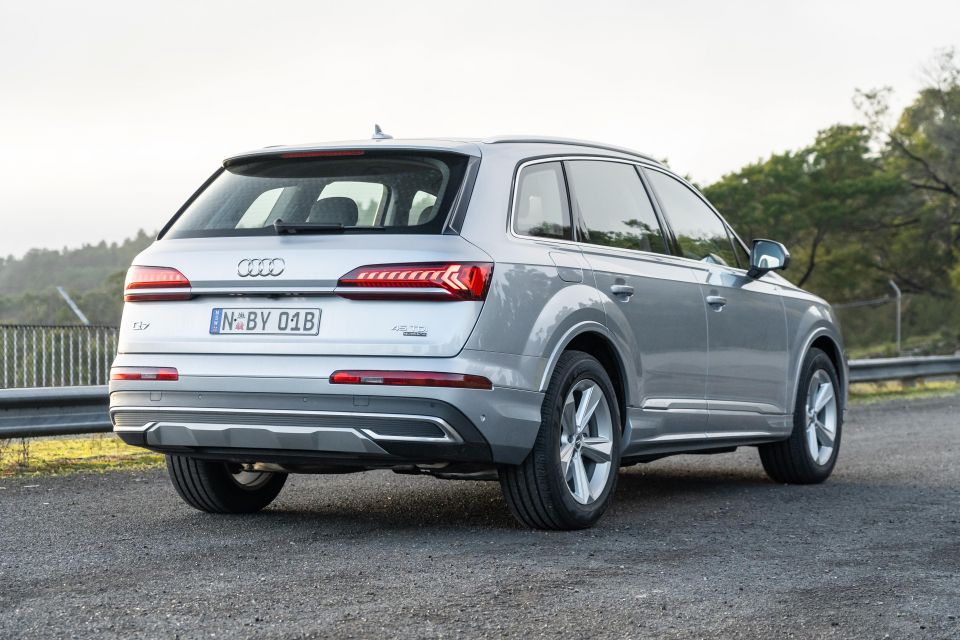

Marketplace Editor
New from
$101,900
excl. on-roads

Marketplace Editor
New from
$101,900
excl. on-roads


Marketplace Editor
New from
$101,900
excl. on-roads

Marketplace Editor
New from
$101,900
excl. on-roads
Quickly see how this car stacks up against its competition. Select any benchmark to see more details.
Where expert car reviews meet expert car buying – CarExpert gives you trusted advice, personalised service and real savings on your next new car.
Forgive me for using Kelis’ Milkshake as inspiration for the excerpt of this review, but I couldn’t help myself.
The Audi Q7 is the kind of ‘soccer-mum/dad bus’ that people actually aspire to buy – add its rivals to the list too, like the BMW X5, Mercedes-Benz GLE, Range Rover Sport and Volvo XC90.
While the big Audi competes in a packed segment, this entry-level 45 TDI is an outlier by virtue of offering a six-cylinder engine with an entry-level price tag, if you discount the five-seat Volkswagen Touareg with which the Q7 shares its underpinnings.
I believe the latest Audi Q7 is one of the absolute best family cars you can buy right now. Here’s why.
The 45 TDI is the base model in the updated Audi Q7 range, with prices starting at $101,900 before on-road costs. Our tester was finished in Florett Silver metallic paint – the only option fitted – bringing the as-tested price to $104,300 before on-roads for the car you see here.
Any car costing north of $100,000 is hardly what you’d call cheap, but the Q7 undercuts just about every rival and offers more kit, perhaps with the exclusion of the related Volkswagen Touareg.

The BMW X5 starts at $102,900 before on-road costs and options, but that’s for the four-cylinder xDrive25d. If you want a six-cylinder X5 you need to spend at least $119,900 for the xDrive30d.
It’s a similar story with the Mercedes-Benz GLE, which is dearer again at $105,700 for the entry-level four-cylinder GLE300d. For the six-cylinder diesel GLE400d, you’re up for a minimum of $124,400.
Worth noting also is BMW and Mercedes-Benz have made a three-row interior a cost option, where the Audi Q7 has seven pews as standard.

Since we’re here, the Range Rover Sport starts at $97,364 in its most basic form with a four-cylinder turbo petrol engine, and at $112,766 for the cheapest, similarly-powered V6 diesel. That said, the Range Rover requires a number of options boxes ticked to get even within breathing distance of the equipment levels offered by the Germans.
Volvo, meanwhile, doesn’t offer anything other than four-cylinder engines these days for the Volvo XC90, instead upping outputs through twin-charging (turbo + super) and plug-in hybrid systems.
The most affordable XC90 is the D5 Momentum, priced from a sharp $89,990 before on-road costs, with the 173kW/480Nm 2.0-litre twin-turbo four-cylinder diesel the only oiler available.

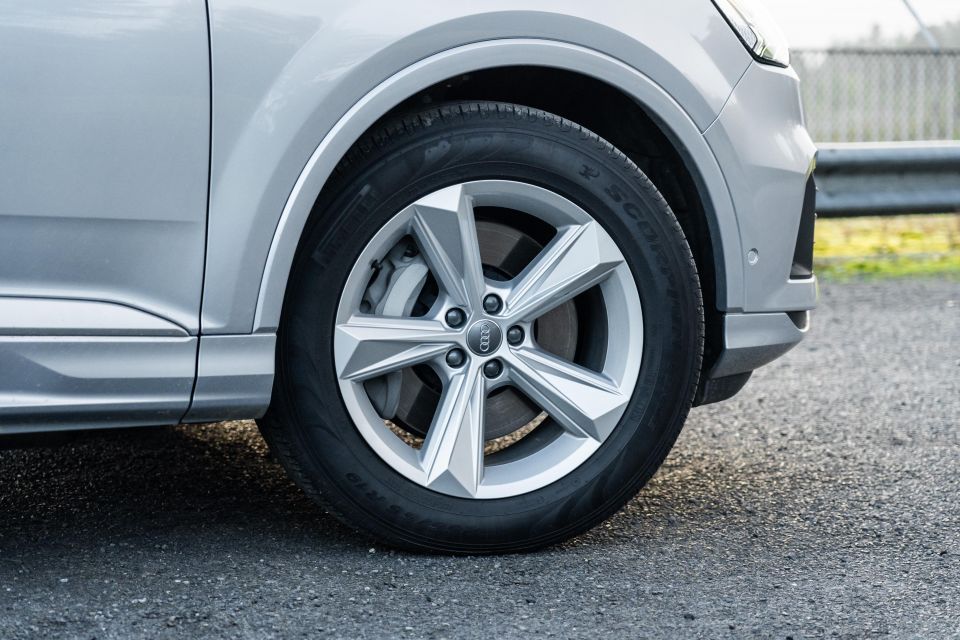
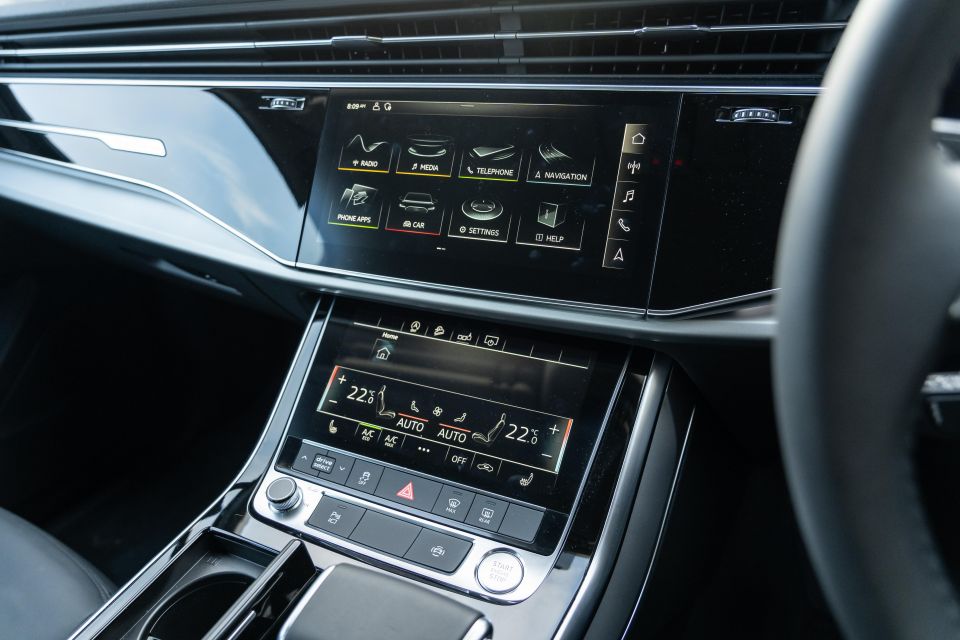
Buy your new car without the stress. It's fast, simple and completely free.

Great service from Travis and team, second time I have used this business would not hesitate to recommend them to anyone
Craig C.
Purchased a Ford Ranger in Sunshine Coast, QLD
CarExpert helped Craig save $7,224 on his Ford Ranger, now let us save you on your next new car.
Get your BEST priceAs is becoming common practice among luxury brands, the entry-level Audi Q7 doesn’t want for much in terms of standard equipment.
Key highlights include 19-inch alloy wheels, adaptive air suspension, Matrix LED headlights with dynamic front and rear indicators, an electric tailgate, power-folding exterior mirrors, three-zone climate control, leather-appointed seat upholstery, electrically-adjustable heated front seats with driver memory, as well as dual-screen infotainment with stacked touchscreen displays (10.1-inch top, 8.6-inch bottom) offering haptic feedback.
There’s also wireless phone charging, online services, wireless Apple CarPlay and wired Android Auto, 12.3-inch Audi virtual cockpit driver’s instruments, a 360-degree parking system, front and rear parking sensors, and an array of driver assist technologies including adaptive cruise control, lane departure warning with lane-keeping assist, blind-spot and rear cross-traffic assist, as well as intersection assist.

As mentioned before the Q7 is fitted with three rows of seats as standard equipment.
Key options available for the base Q7 include a powered panoramic sunroof ($4000, ouch), and a Premium Plus package ($5000) which adds 21-inch alloys, four-zone climate control, rear privacy glass, a 19-speaker Bose 3D premium sound system, and the configurable ambient interior lighting package.
You can also opt for 20-inch alloys on their own ($2200), a stealthy black exterior design package ($1450), electric steering column adjustment ($900), and a head-up display ($3200?!).

Yes. In Australia all Q7 models with V6 diesel engines wear a five-star ANCAP safety rating with 2015 date stamp, based on Euro NCAP testing of the pre-facelift model.
When it was tested in 2015 the Q7 scored 94 per cent for adult occupant protection, 88 per cent for child occupant protection, 70 per cent for pedestrian protection, and 76 per cent for safety assist.
At the time of testing, the Audi Q7 was fitted with dual frontal, side chest and curtains airbags as standard. Electronic Brake Distribution (EBD), Emergency Brake Assist (EBA), Autonomous Emergency Braking (AEB), and a manually set speed limiter were also standard. Advanced seat belt reminders are fitted to all seats
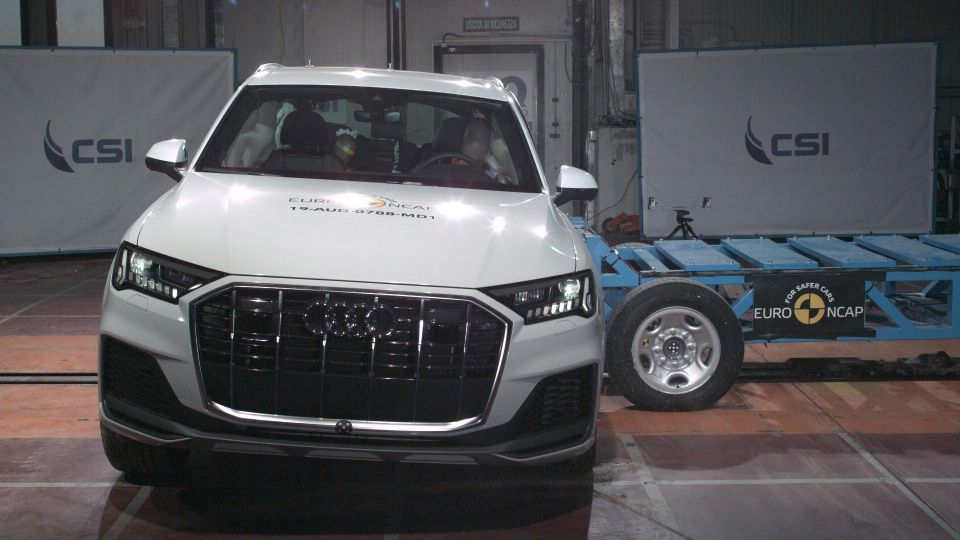
While not reflected in Australia just yet, the facelifted Audi Q7 has since been re-tested by Euro NCAP in 2019, again achieving a five-star safety rating for all variants (including SQ7) with minor adjustments to the scores.
Against the latest criteria, the Q7 scored 92 per cent for adult occupant protection, 86 per cent for child occupant protection, 71 per cent for vulnerable road users, and 72 per cent for safety assist.
Key feedback includes just marginal chest protection for the driver and passenger in the frontal offset test, as well as marginal protection for the rear passenger in the full-width frontal test.
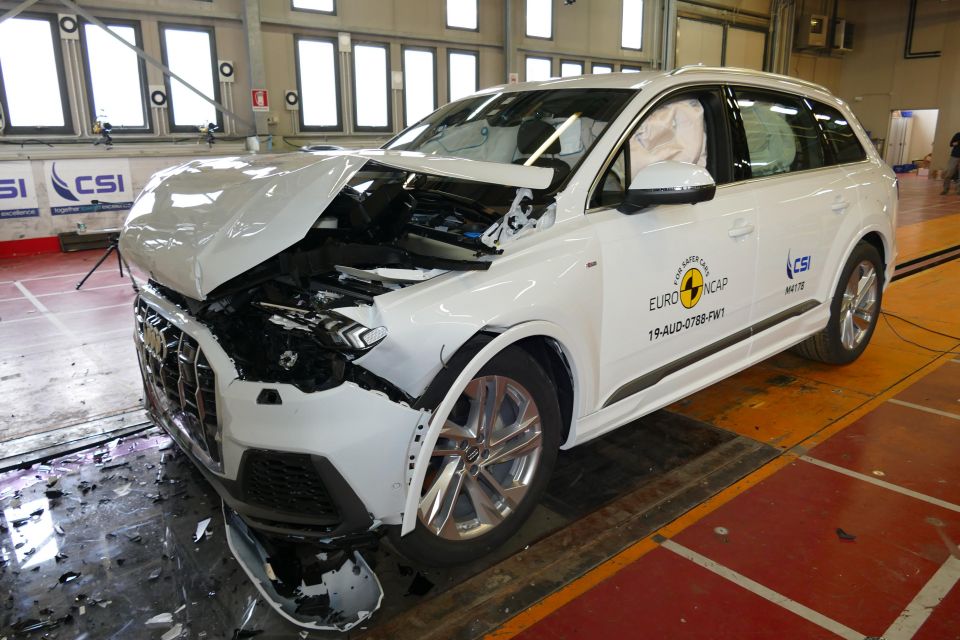
The Q7 also got full marks for crash-test performance with regards to child occupant protection, though lost marks as some European child seats weren’t able to be fitted to certain spots in the vehicle – namely the rearmost two seats and the second-row centre seat for certain capsules.
Performance of the AEB system was rated ‘Good’ or ‘Adequate’ for most situations, including mitigating collisions with vehicles, pedestrians and cyclists. Only detecting a pedestrian crossing the road at night returned a ‘Marginal’ rating for performance.
The lane-keep system was rated ‘Good’, but emergency lane-keeping and the human machine interface (HMI) was deemed ‘Adequate’.
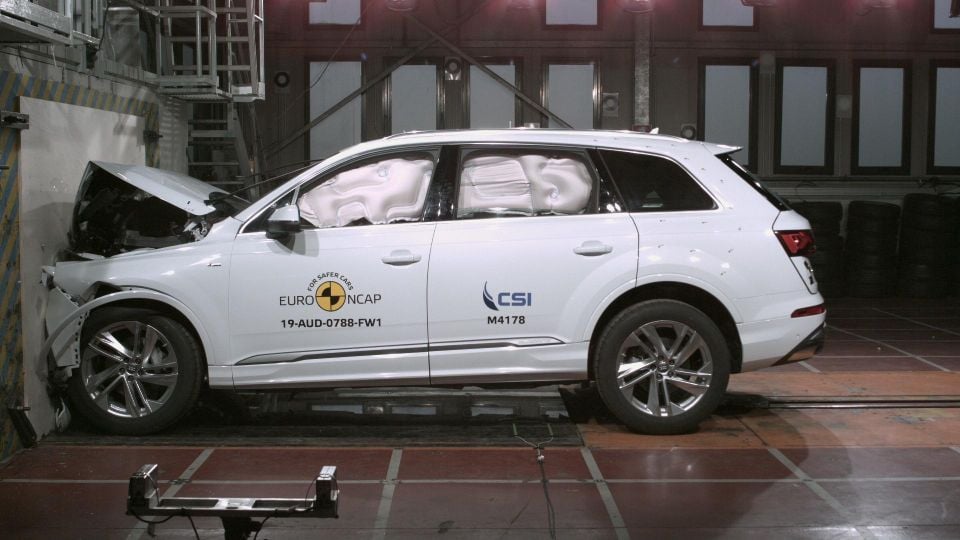
The Australian-market Audi Q7 comes standard with front airbags for driver and passenger, side airbags for front and rear side passengers, and head level curtain airbags for front and rear.
Other features include tyre pressure monitoring, driver attention monitoring and seatbelt reminders for all seats, including illuminated buckles.
All-speed autonomous emergency braking (up to 250km/h) with pedestrian (up to 85km/h) and cyclist detection is standard fit, as is adaptive cruise control with stop/go and traffic jam assist, dynamic high-beam, front cross-traffic AEB, blind-spot and rear cross-traffic assists, as well as front and rear parking sensors with 360-degree cameras.
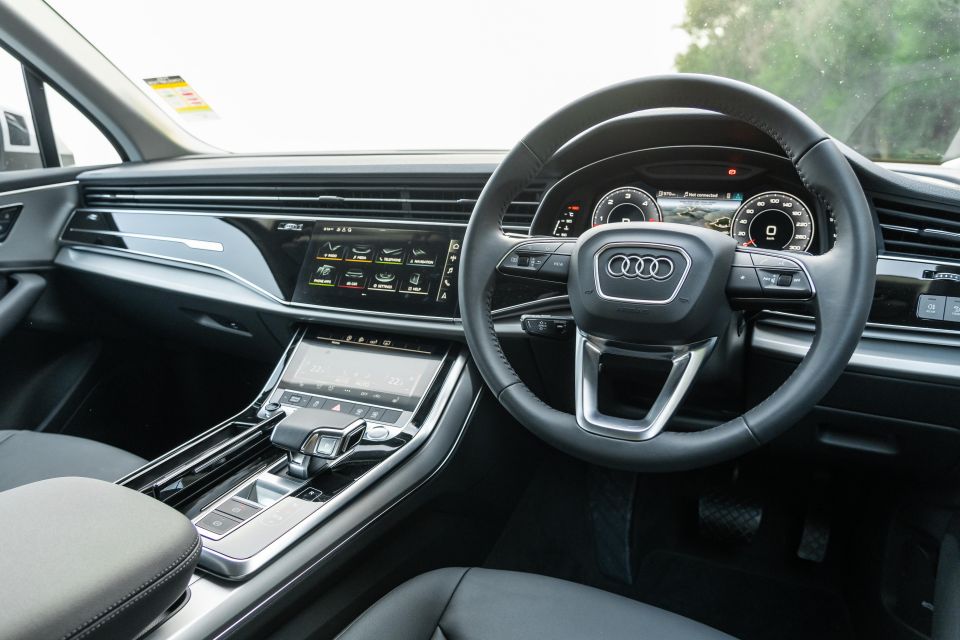
The usual Audi cliché of top-notch cabin quality and tactility holds up here, especially given the Q7 is one of the company’s higher-end nameplates.
Audi’s mid-life refresh brought an overhauled cockpit borrowed from the related Q8, also rolling out to other nameplates like the A6, A7 and A8.
While the new-age design of the latest Mercedes-Benz cars has a certain ‘wow’ factor with free-standing tablet style displays and funky touch pad, the cleaner, more integrated look of the latest MMI touch system is my pick.


I know the move to touch displays has raised some eyebrows, but the Audi system is quite intuitive and the haptic response brings back an element of confidence you get when using buttons.
Up top you have a 10.1-inch touchscreen, below which sits an 8.6-inch unit. The top controls main infotainment and vehicle functions while the bottom is home to climate and seat heating functions. It’s much more like a conventional interior layout, but with a modern twist.
It can be a little intimidating at first for the uninitiated, but once you get used to ‘pressing’ the screen and getting the haptic ‘click’ confirming your selection, it’s actually quite simple to use.
My main complaint is that even the higher screen is mounted low and out of the driver’s line of sight. You’d want to be limiting interaction with the screen where appropriate, because it feels like you need to take your eyes off the road.
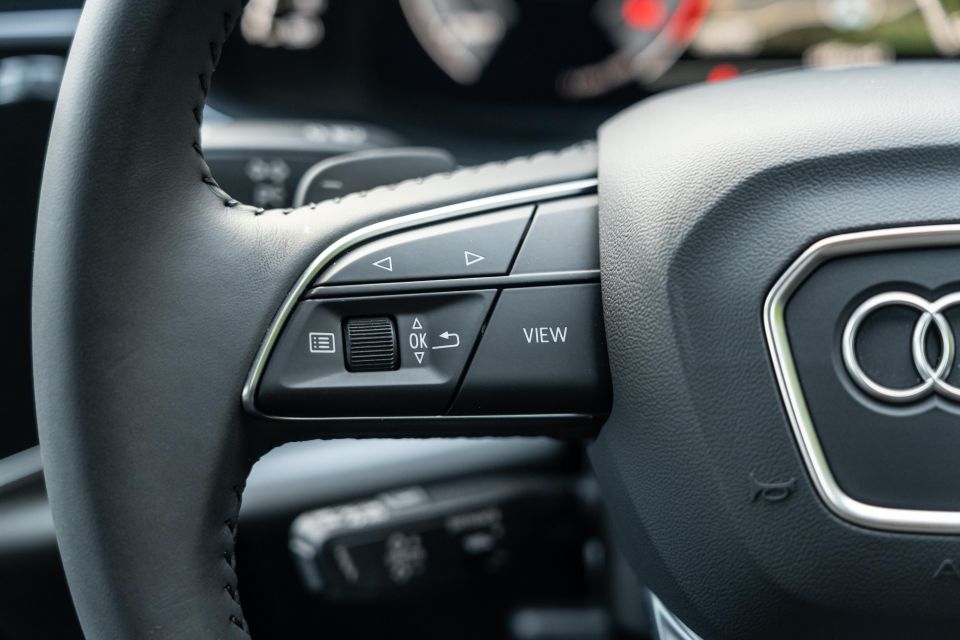
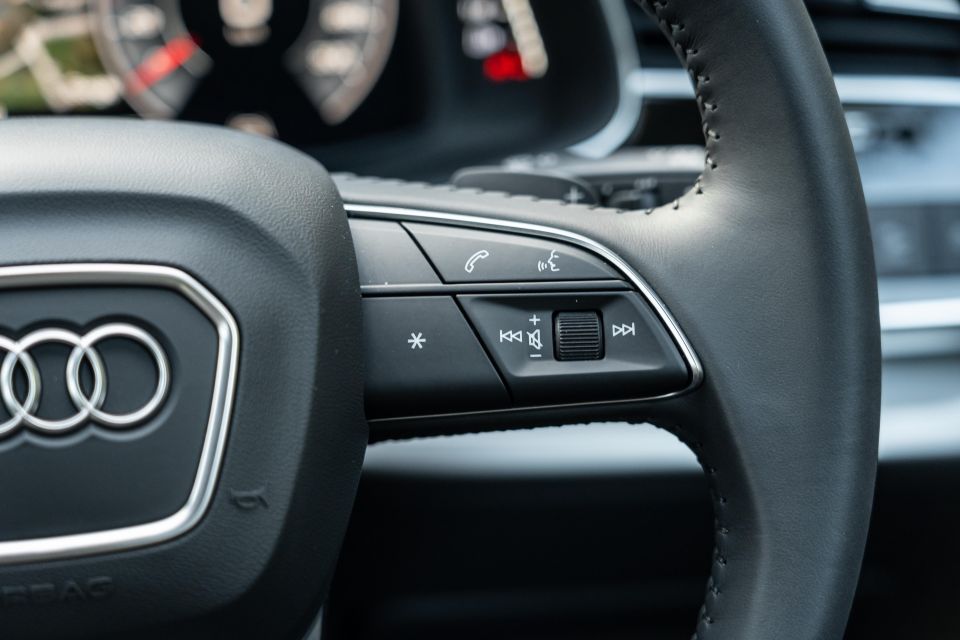
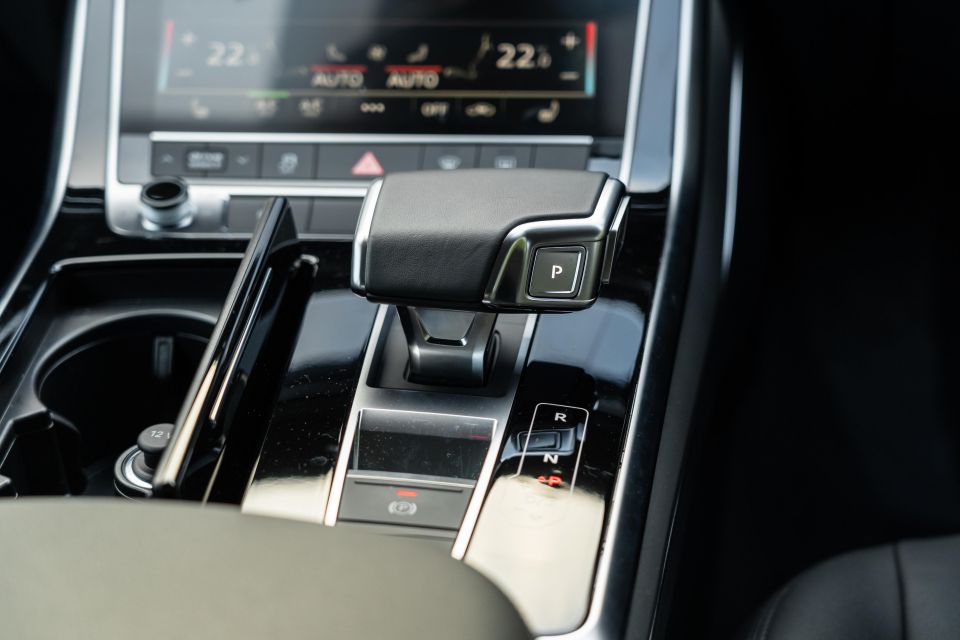
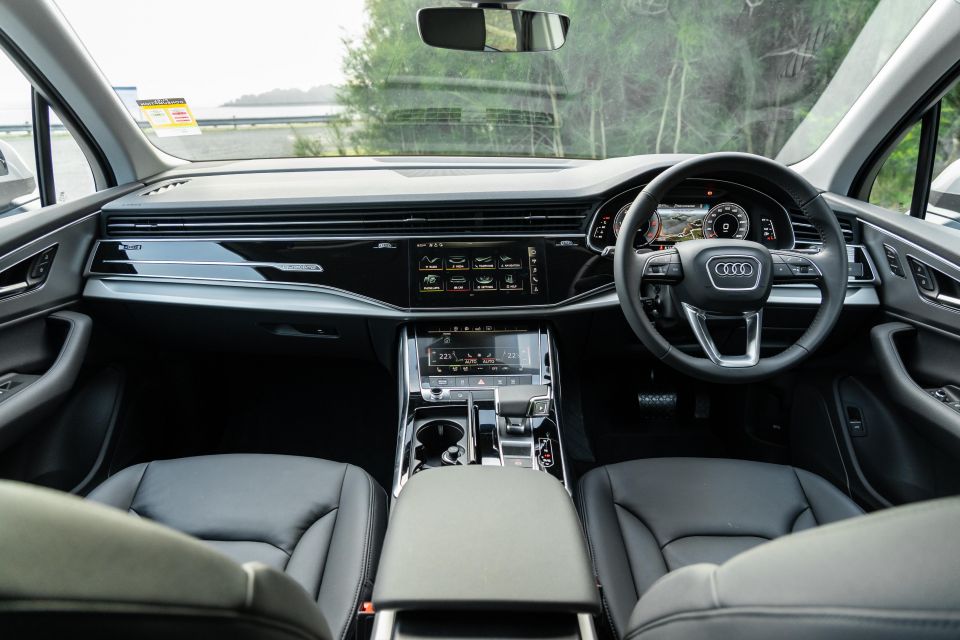
That said, the driver is able to toggle most functions on the move via the steering wheel, which feels lovely in the hand and puts a good amount of buttons at your thumb tips.
Even better, if you hook up to wireless Apple CarPlay (which worked just about flawlessly every time) or wired Android Auto, any navigation inputs, phone calls or song skips can be done with a button on the multifunction wheel or via voice commands.
It’s refreshing to be able hide your phone away under the centre armrest in its wireless charging cradle and not be fumbling around with cables and adaptors like you do in, say, the Mercedes-Benz GLE. You literally hop in, pop the phone in the holder, and off you go – initial set up is pretty easy, too.

Ahead of the driver is the gorgeous 12.3-inch virtual cockpit, which remains my favourite digital instrument cluster. Where most manufacturers make their units too limited in functionality or too edgy in terms of design and implementation, the Audi cluster retains a familiar layout to those coming from more analogue setups, while offering a degree of customisation tech heads like myself can appreciate.
New for the latest iteration is the option of ‘Sport’ readouts like the bar counters you’ll find in S and RS models, bolstering the existing traditional dials that can be toggled in normal and small sizes.
The refreshed interface employs a flatter, more contemporary skin than before and the standard Google Maps adds another level of class compared to the systems used by parent Volkswagen and its mainstream Skoda subsidiary.

Where expert car reviews meet expert car buying – CarExpert gives you trusted advice, personalised service and real savings on your next new car.
Space and storage up front is mostly good – keeping in mind this is a vehicle designed for families. The cupholders (hidden by a weighted lid) are large enough for most cups but won’t carry larger bottles, though there’s a cute little slot for your key.
The central storage unit where the phone charger is located is also disappointingly small, only offering said phone pad and a little cubby best left for sunglasses or spare keys. However, the door pockets are nice and large, and can fit larger bottles and then some.
Material quality is also excellent, with an abundance of soft-touch materials right down to lower sections of the cabin, something a number of rivals cannot match. We would, though, be ticking the box to have one of the wood trim inserts ($1400, eek!) as the standard silver plastic is a little low-rent.

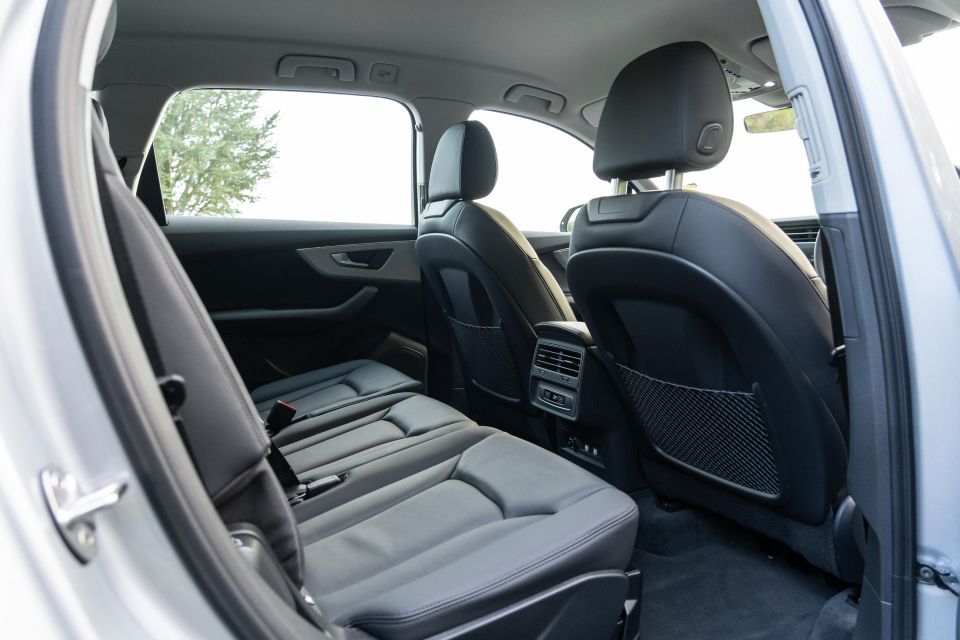

In the second row, the Q7 again proves even at the lower end of the segment, it’s among the best in class.
As standard there’s a third zone for the climate control – BMW and Mercedes-Benz charge more – and there’s a great amount of space for adults in all three seats. There’s also two USB charging ports, a 12V socket, and map pockets behind both front seats.
One of the Q7’s trump cards is the individual rear centre seat, which is large enough to accommodate a third ISOFIX child seat which most vehicles do not offer. Parents with two or three little ones may be swayed by this alone. When not in use, the centre seat offers a fold-down armrest with cupholders, and the entire second row can be slid fore and aft as well as reclined in each individual seat.
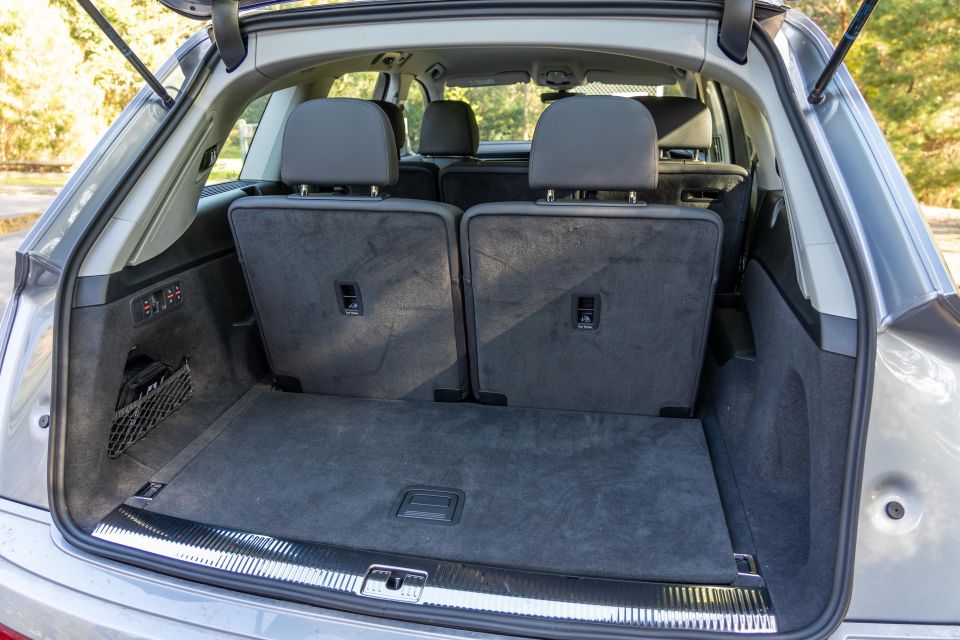

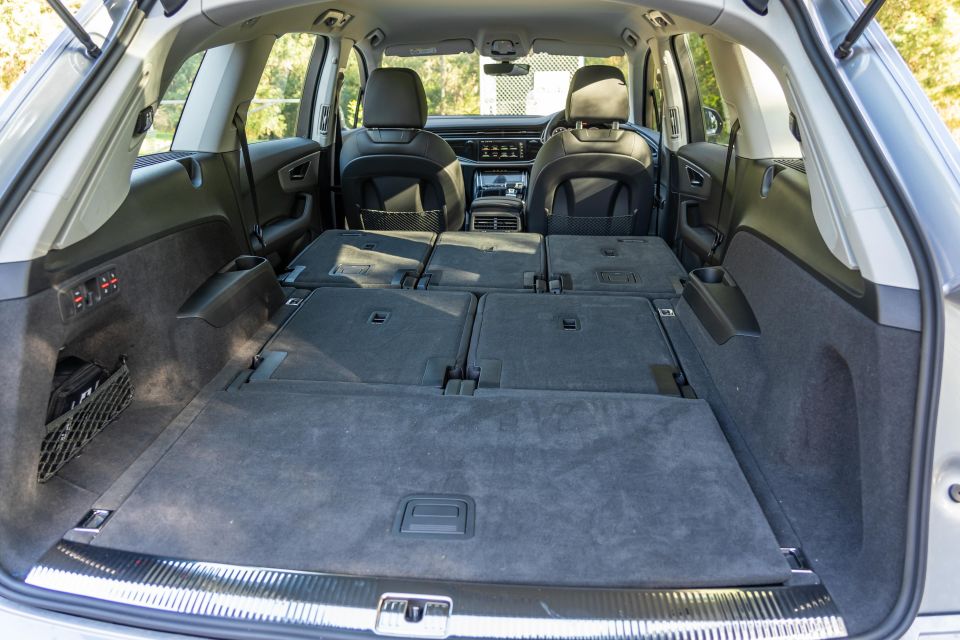
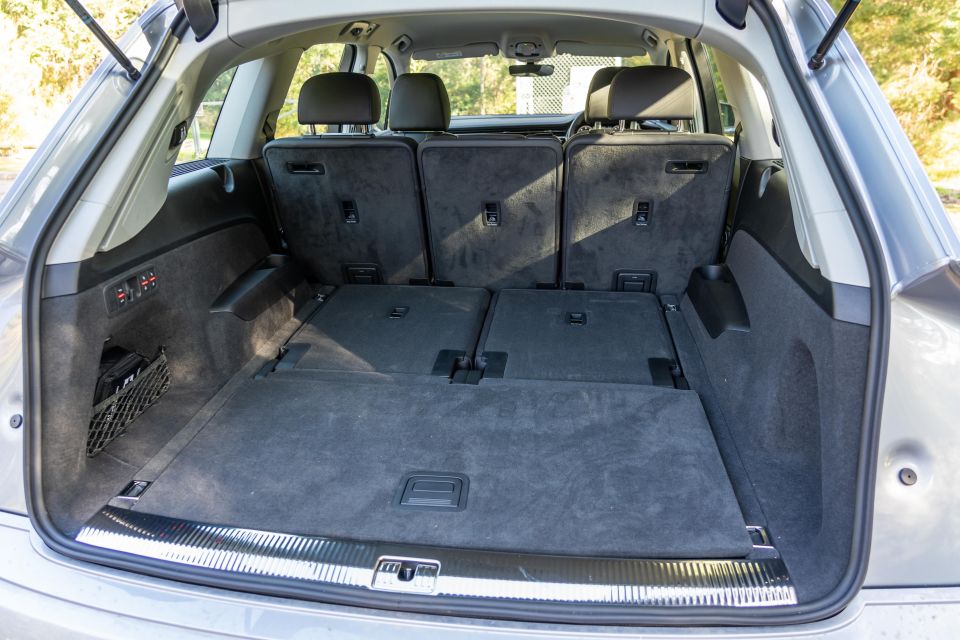
The third row isn’t quite at people mover levels of space, but kids will be happy back there – as will smaller adults for short trips. It’s also more accommodating than the optional third rows in the X5 and GLE, though the XC90’s taller roofline makes it a better option for carrying seven people on a semi-regular basis.
When not in use, the sixth and seventh seats (both with top-tether points), can be folded flat to open up 740L of luggage space in five-seat form. Drop the second row and there’s a massive 2050L on offer, while there’s a decent 295L behind the third row when all seats are in use.
In five-seat form, the Q7 betters both the GLE and X5 though can’t quite match its Touareg cousin (810L) for space. With all seats folded, it’s on par with the Mercedes and offers more room than the BMW and Volkswagen.
The Volvo is a better load-lugger – on paper at least – with a huge 356L with seven seats in use, 1007L in five-seat form, and 1868L with the second and third rows folded flat.
All Audi Q7 models in Australia have a tyre repair kit in space of a spare wheel, which is worth keeping in mind if you do a lot of country touring away from dealerships and tyre shops.
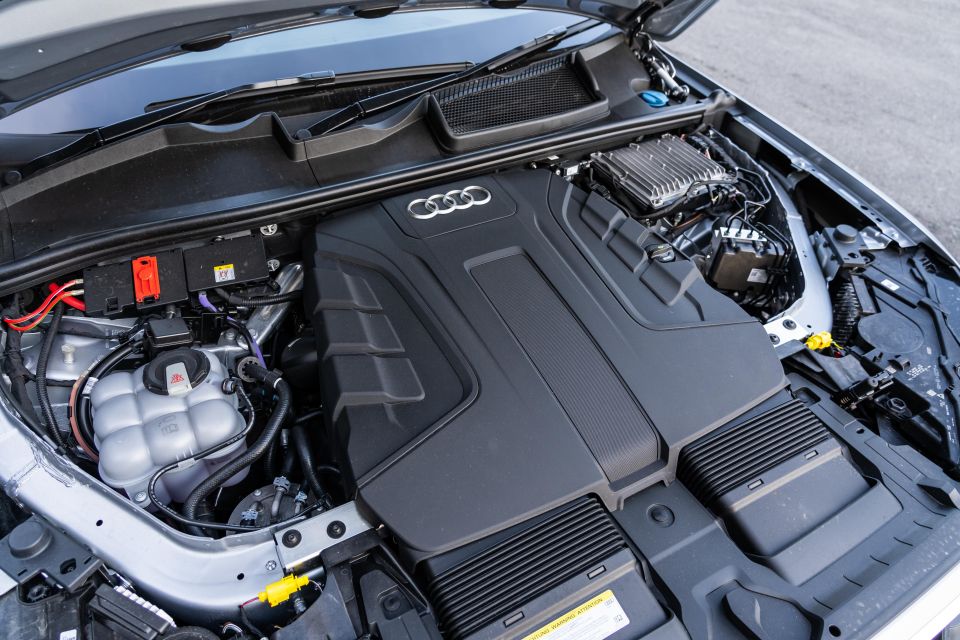
Non-performance versions of the Q7 feature a 3.0-litre V6 turbo-diesel, equipped with 48V mild-hybrid technology.
In the 45 TDI quattro, the V6 diesel makes a modest 170kW of power and 500Nm of torque – the latter available from 1750rpm to 3250rpm.
The MHEV system incorporates a belt alternator starter hooked up to a 48V on-board electrical system and a lithium-ion battery, allowing the engine to coast under low load, and allowing the stop/start system to engage from as high as 22km/h to cut fuel consumption and emissions.

Unlike the 48V systems in performance Audis like the SQ7, the technology in the Q7 45 TDI and 50 TDI doesn’t appear to offer any performance boost, rather solely enhancing efficiency. Audi says the technology can reduce consumption by as much as 0.7L/100km.
The coasting function can engage when the driver takes their foot off the accelerator at speeds between 55km/h and 160km/h, with the Q7 either rolling along at idle or with the engine switched off for up to 40 seconds at a time.
Audi says all versions of the Q7 (including the SQ7), can tow a maximum of 3500kg(braked), with a maximum ball weight of 350kg and gross combined weight of 6500kg (SQ7’s GCW is 6655kg).
The Q7’s capable towing capacity is likely the Audi’s main point of difference from the uber-practical Volvo XC90, which is rated to tow a maximum of 2400kg.

Under brakes, the system can also recuperate up to 8kW of energy which is stored in the lithium-ion battery.
Drive is sent to a quattro all-wheel drive system – which typically runs a 40:60 front-rear split – via an eight-speed torque converter.
Audi claims the Q7 45 TDI can accelerate from 0-100km/h in 7.3 seconds, which isn’t far off the times quoted by some hot hatches, while using diesel at a rate of 7.0L/100km on the combined cycle.
Comparing the 45 TDI to the entry-level versions of rival models mentioned earlier, some may notice the outputs of the Audi’s V6 diesel are pretty much on par with the four-cylinder oilers in the BMW, Mercedes-Benz and Volvo.
But the Audi’s peak torque and power bands come on tap earlier than the four-pot diesels, it can tow around 800kg more, and for most buyers there’s an inherent preference for a larger, less stressed powertrain in such a big vehicle.
Six-cylinder diesels tend to also be more refined, and the Q7’s fuel claim is within 0.1L/100km of its German four-cylinder rivals, too.

Rather nicely, with some small quirks.
Having recently driven a Volkswagen Touareg I had a pretty good idea of what to expect from the Audi given the shared underpinnings and similar powertrain.
What the Audi does, though, is take the already excellent ingredients from its VW-badged sibling and make an even better overall experience.
There’s an added level of refinement and comfort in the Q7, which is no doubt aided by the better finished cabin but there seems to be even better sound insulation and an added degree of compliance in the ride – likely helped by the 19-inch wheels and chubbier tyres fitted as standard to the 45 TDI.
On the road there’s little to no diesel clatter from the 3.0-litre oiler and there’s little in the way of road and wind noise, even at higher speeds on country roads.
Regardless of the conditions, the Q7 is a comfortable, quiet place to be, offering mostly effortless acceleration thanks to the 500Nm on tap from just 1750rpm.
However, like many luxury vehicles with the eight-speed auto sourced from ZF, there’s a feeling of hesitation when setting off from a standstill and also shifting into second gear.
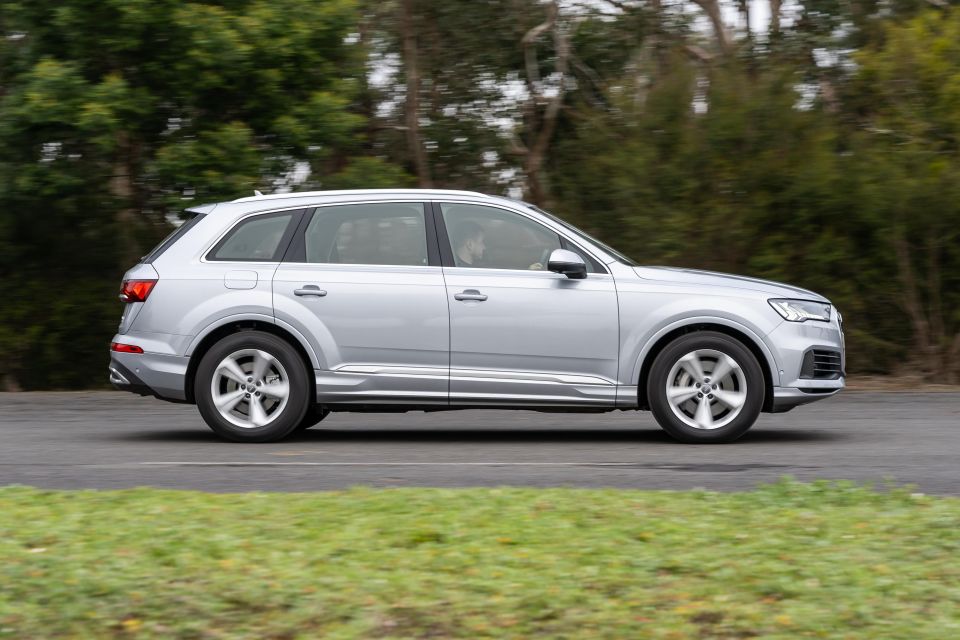
In the case of the Q7, this is likely exacerbated by turbo lag. There’s not a lot happening between when you accelerate off the line and hit that 1750rpm peak torque band.
What also doesn’t help is that the transmission typically shifts between 2000 and 2250rpm in the name of efficiency, so the first couple of ratios tend to leave you in a torque hole if you’re trying to apply light throttle.
If you don’t modulate your right foot in line with the powertrain’s talents, there can be the occasional shunt as the transmission hunts for the right rev band to give you the response it thinks you want. We found the best way to counter this was a gradual increase in throttle input to keep the engine revving past the usual shift point, rather than a sudden stab which resulted in a neck-snapping kick in the back.
The MHEV system is very eager to engage the coasting function, and the stop/start system is much smoother than most, allowing you to coast to a stop.
It’s also quick to fire up again once you take your foot off the brake, though it can get a little confused when rolling to an intersection where the light turns green before you hit a stop. On multiple occasions (funnily enough at the same intersection), the Q7 fired back up in third gear at under 10km/h, needing a good couple of seconds to figure itself out before smooth progress resumed.
Once on the move though, the Q7 is wonderful. It wafts along Melbourne’s imperfect roads with aplomb, even over the hardest hits.
The steering is light but weight builds as you wind on lock, and despite its 5063mm length the Q7 is surprisingly manoeuvrable in tight streets and car parks, thanks to the excellent all-round vision (big glasshouse and mirrors help) and handy 360-degree camera system – which also allows you to create a 3D view of the car and its surroundings via the top infotainment display.
It’s certainly no corner carver in this comfort-oriented specification, but the Q7 can certainly hold its own on a twisting back road with good body control and limited lean, without the need for 48V anti-roll bars.
Even at 110km/h the 3.0-litre diesel is barely noticeable humming away well under 2000rpm in eighth gear, and the big footprint lends a very stable and confident feel on the road – most European vehicles like the Q7 are designed to sit happily at Autobahn speeds, after all.
Like it does in town, the Q7’s ride at speed is settled and tuned more for wafty comfort. Overtaking is an easy task with plenty of punch from the V6 diesel, too.
It certainly feels like it could handle a fully-loaded cabin with seven seats in play with a bit of luggage, as well as tow a large caravan or boat.
The standard suite of assistance systems comes in handy too, including blind-spot monitoring (which helps in town given the Q7’s length), and the intuitive adaptive cruise control system. Audi’s lane-keep assist proved to be one of the less intrusive systems on the market as well, not suddenly tugging at the wheel like more aggressive systems.
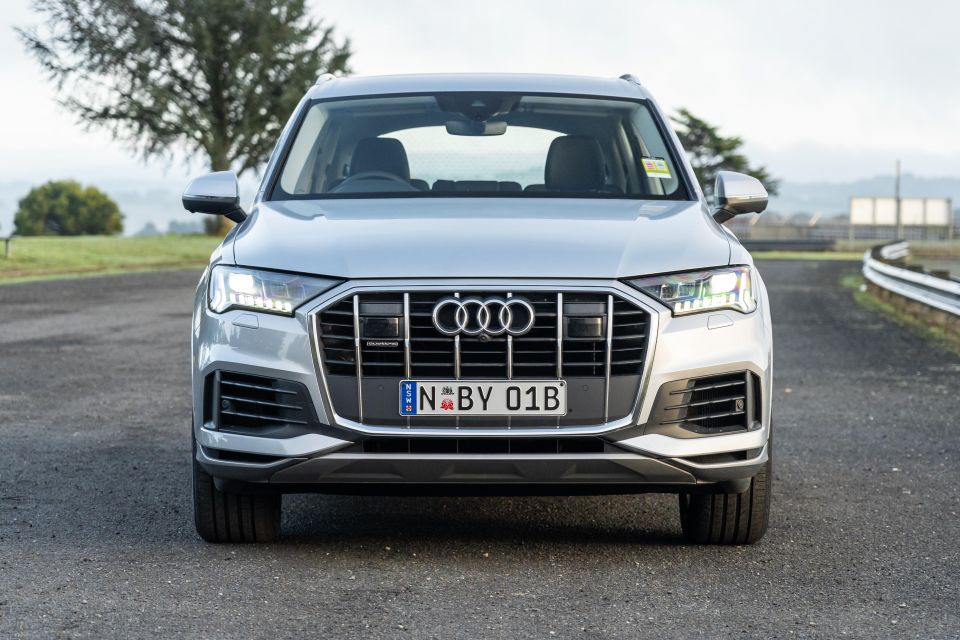
The Q7 is covered by Audi Australia’s standard three-year, unlimited-kilometre warranty with roadside assistance for the same 36-month period. Unfortunately, Audi hasn’t yet decided to offer five years of coverage like Mercedes-Benz and Volvo, nor its Volkswagen parent.
In terms of service and maintenance, Audi offers three- and five-year ‘Genuine Care Service Plans’. For the 36-month plan, there’s an upfront charge of $2310, while the 60-month package costs $3190.
Mileage limits for those plans are 45,000km and 75,000km respectively, with costs averaging $770 per annum for the three-year plan and $638 annually for the five-year plan.
In terms of real-world economy, we averaged an indicated 8.2L/100km over 545 kilometres of mixed driving during our week of testing, skewed to urban driving.
Considering this is a 2.2-tonne SUV with a V6 engine, achieving similar fuel economy to my VW Golf GTI is not a bad effort at all. With its 85L tank you can easily get over 1000km per fill, especially with a little more freeway touring.

Buy your new car without the stress. It's fast, simple and completely free.

Great service from Travis and team, second time I have used this business would not hesitate to recommend them to anyone
Craig C.
Purchased a Ford Ranger in Sunshine Coast, QLD
CarExpert helped Craig save $7,224 on his Ford Ranger, now let us save you on your next new car.
Get your BEST priceThis was my first experience with the Audi Q7, and I came away thoroughly impressed with just how good of an all-rounder the big German SUV is even in its most basic form.
It’s spacious, comfortable, loaded with technology, and efficient in real-world driving. Also, compared to its German rivals in particular, it’s more affordable and packs more features including seven seats as standard.
As a 5+2 seater, it’s pretty hard to beat, but if you require the third row more often or for taller passengers, an XC90 might be a better bet, unless you can stretch to a larger BMW X7 or Mercedes-Benz GLS – though both will cost you tens of thousands more.
I see the Audi Q7 as something of a modern successor to the VW Phaeton of the early 2000s – once lauded as one of the best cars in the world – in the sense it shares the capable mechanical underpinnings with high-end models from Bentley and Porsche, offers first-rate interior fit and finish, with the luxury features and technologies you expect of a premium vehicle.
Should you be in the fortunate position to be able to drop six figures on a luxury car for the family, the Audi dealer would be the first stop on my list.
Where expert car reviews meet expert car buying – CarExpert gives you trusted advice, personalised service and real savings on your next new car.
James is an automotive journalist based in Melbourne, Australia. Before joining CarExpert.com.au in 2020, James has worked at leading auto media outlets including Carsales and CarAdvice, as well as at Pulse agency for Ford Australia's communications team. In 2019 James made Mumbrella's 'Top 20 most prolific web authors in Australia' list after publishing 1,360 articles between March 1, 2018 and February 28, 2019 for CarAdvice. James is also an Ambassador for Drive Against Depression – an Australian charity whose mission is to support mental wellness through the freedom of driving and a shared love of cars.


Max Davies
5 Days Ago


Josh Nevett
3 Days Ago


Max Davies
3 Days Ago


Max Davies
2 Days Ago
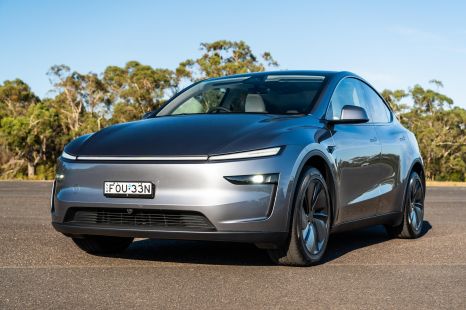

CarExpert.com.au
2 Days Ago
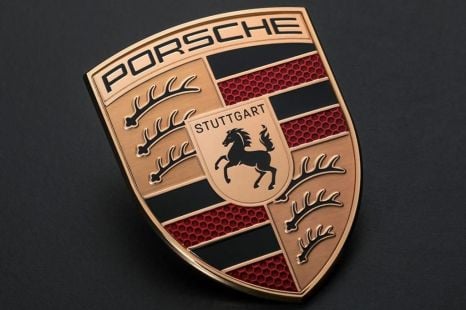

Damion Smy
2 Days Ago